Holmes Institute T2 2019 HA3042 Taxation Law Assignment
VerifiedAdded on 2022/11/10
|7
|2293
|180
Homework Assignment
AI Summary
This taxation law assignment solution addresses two key scenarios related to Australian taxation. The first part provides tax advice to an Australian resident, Jasmine, who is selling assets and retiring. It covers the applicability of capital gains tax (CGT) on her main residence, car, business assets, personal usage assets, and collectibles, considering relevant ATO rules and small business concessions. The second part concerns John, a business owner, and the capital allowance and depreciation of a CNC machine imported from Germany. The analysis determines the allowable costs for capital allowance and the starting date for calculating the decline in the machine's value, considering the Uniform Capital Allowances (UCA) rules and relevant legislations. The assignment provides a detailed breakdown of the tax implications for each situation, including the application of relevant laws and regulations.
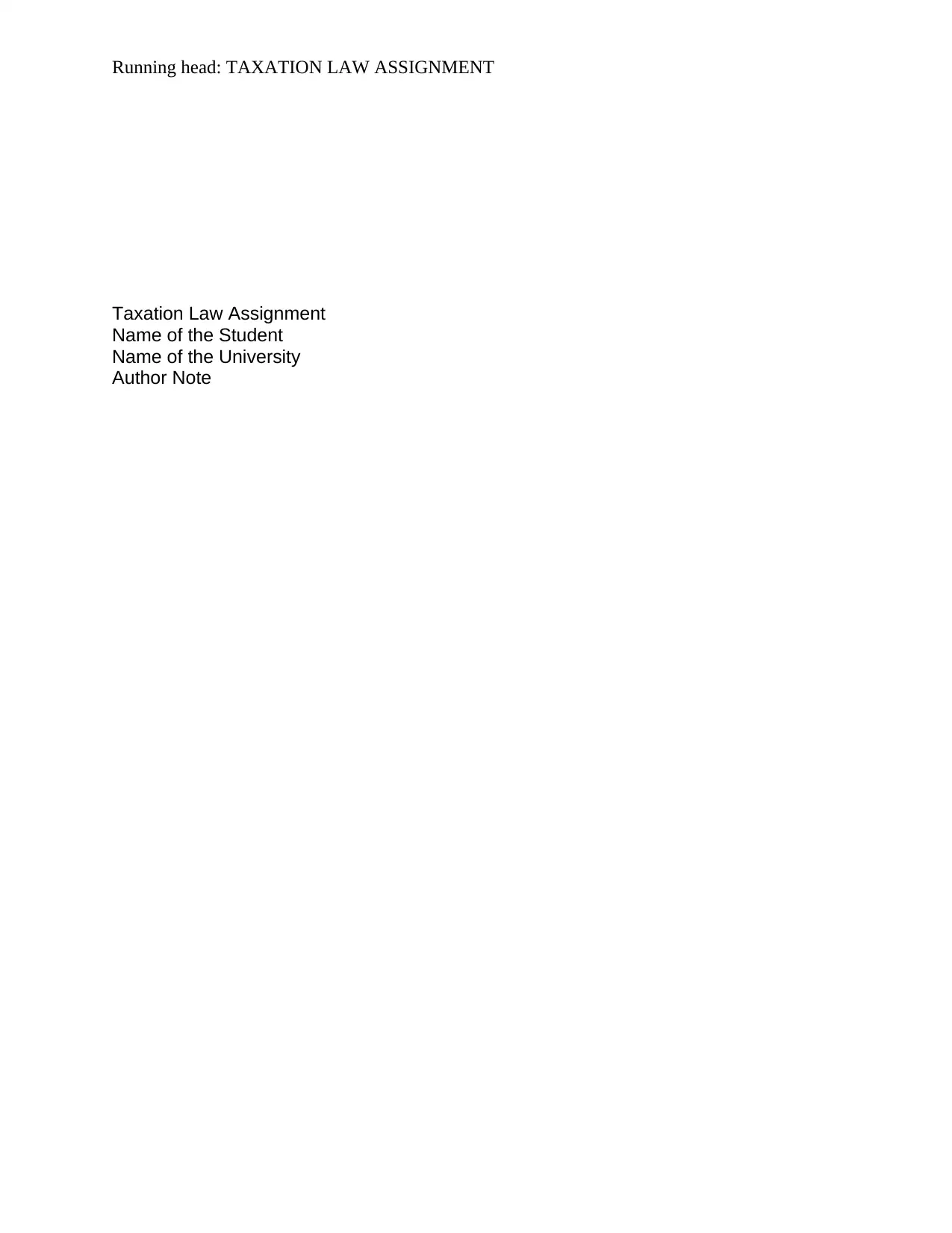
Running head: TAXATION LAW ASSIGNMENT
Taxation Law Assignment
Name of the Student
Name of the University
Author Note
Taxation Law Assignment
Name of the Student
Name of the University
Author Note
Paraphrase This Document
Need a fresh take? Get an instant paraphrase of this document with our AI Paraphraser
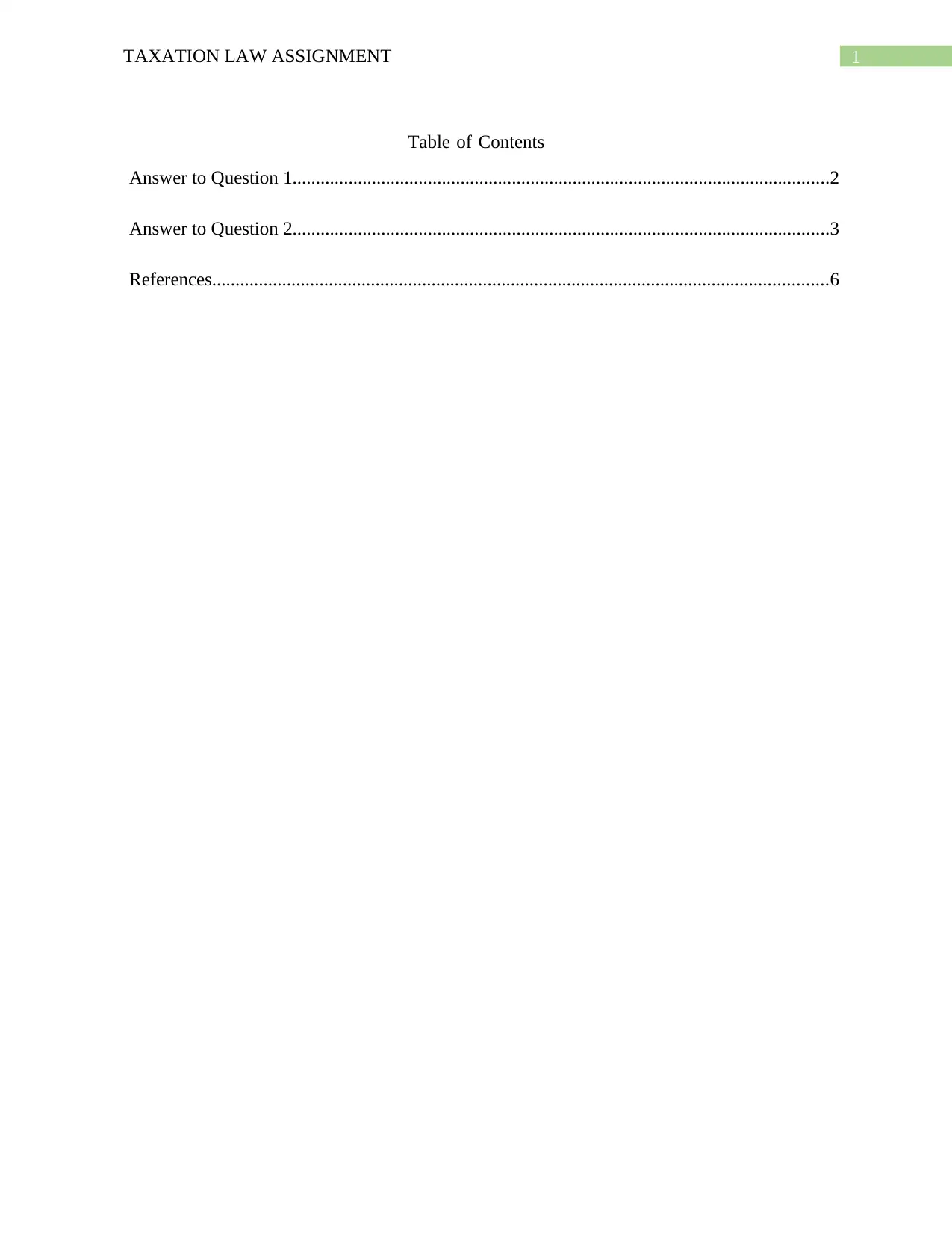
1TAXATION LAW ASSIGNMENT
Table of Contents
Answer to Question 1...................................................................................................................2
Answer to Question 2...................................................................................................................3
References....................................................................................................................................6
Table of Contents
Answer to Question 1...................................................................................................................2
Answer to Question 2...................................................................................................................3
References....................................................................................................................................6
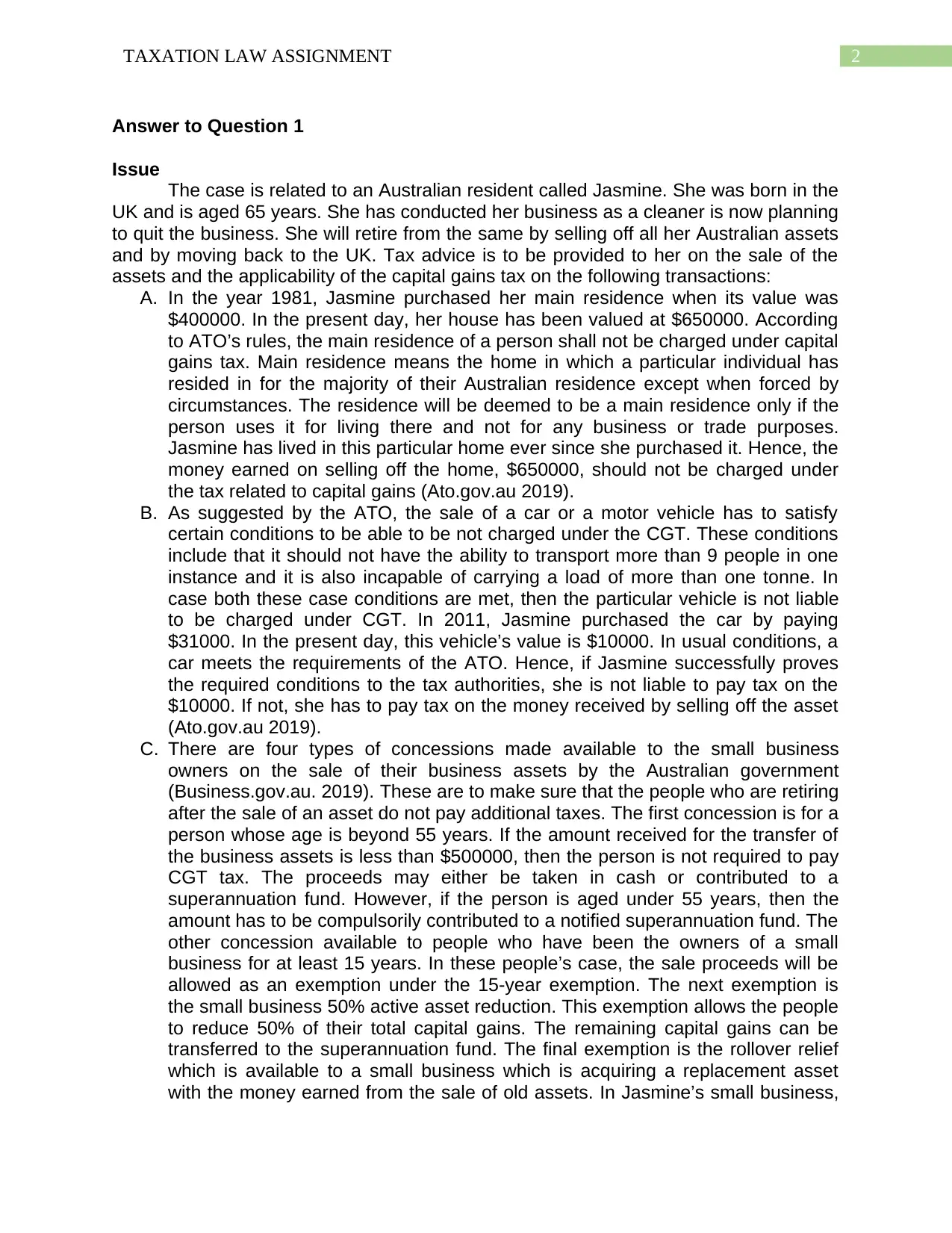
2TAXATION LAW ASSIGNMENT
Answer to Question 1
Issue
The case is related to an Australian resident called Jasmine. She was born in the
UK and is aged 65 years. She has conducted her business as a cleaner is now planning
to quit the business. She will retire from the same by selling off all her Australian assets
and by moving back to the UK. Tax advice is to be provided to her on the sale of the
assets and the applicability of the capital gains tax on the following transactions:
A. In the year 1981, Jasmine purchased her main residence when its value was
$400000. In the present day, her house has been valued at $650000. According
to ATO’s rules, the main residence of a person shall not be charged under capital
gains tax. Main residence means the home in which a particular individual has
resided in for the majority of their Australian residence except when forced by
circumstances. The residence will be deemed to be a main residence only if the
person uses it for living there and not for any business or trade purposes.
Jasmine has lived in this particular home ever since she purchased it. Hence, the
money earned on selling off the home, $650000, should not be charged under
the tax related to capital gains (Ato.gov.au 2019).
B. As suggested by the ATO, the sale of a car or a motor vehicle has to satisfy
certain conditions to be able to be not charged under the CGT. These conditions
include that it should not have the ability to transport more than 9 people in one
instance and it is also incapable of carrying a load of more than one tonne. In
case both these case conditions are met, then the particular vehicle is not liable
to be charged under CGT. In 2011, Jasmine purchased the car by paying
$31000. In the present day, this vehicle’s value is $10000. In usual conditions, a
car meets the requirements of the ATO. Hence, if Jasmine successfully proves
the required conditions to the tax authorities, she is not liable to pay tax on the
$10000. If not, she has to pay tax on the money received by selling off the asset
(Ato.gov.au 2019).
C. There are four types of concessions made available to the small business
owners on the sale of their business assets by the Australian government
(Business.gov.au. 2019). These are to make sure that the people who are retiring
after the sale of an asset do not pay additional taxes. The first concession is for a
person whose age is beyond 55 years. If the amount received for the transfer of
the business assets is less than $500000, then the person is not required to pay
CGT tax. The proceeds may either be taken in cash or contributed to a
superannuation fund. However, if the person is aged under 55 years, then the
amount has to be compulsorily contributed to a notified superannuation fund. The
other concession available to people who have been the owners of a small
business for at least 15 years. In these people’s case, the sale proceeds will be
allowed as an exemption under the 15-year exemption. The next exemption is
the small business 50% active asset reduction. This exemption allows the people
to reduce 50% of their total capital gains. The remaining capital gains can be
transferred to the superannuation fund. The final exemption is the rollover relief
which is available to a small business which is acquiring a replacement asset
with the money earned from the sale of old assets. In Jasmine’s small business,
Answer to Question 1
Issue
The case is related to an Australian resident called Jasmine. She was born in the
UK and is aged 65 years. She has conducted her business as a cleaner is now planning
to quit the business. She will retire from the same by selling off all her Australian assets
and by moving back to the UK. Tax advice is to be provided to her on the sale of the
assets and the applicability of the capital gains tax on the following transactions:
A. In the year 1981, Jasmine purchased her main residence when its value was
$400000. In the present day, her house has been valued at $650000. According
to ATO’s rules, the main residence of a person shall not be charged under capital
gains tax. Main residence means the home in which a particular individual has
resided in for the majority of their Australian residence except when forced by
circumstances. The residence will be deemed to be a main residence only if the
person uses it for living there and not for any business or trade purposes.
Jasmine has lived in this particular home ever since she purchased it. Hence, the
money earned on selling off the home, $650000, should not be charged under
the tax related to capital gains (Ato.gov.au 2019).
B. As suggested by the ATO, the sale of a car or a motor vehicle has to satisfy
certain conditions to be able to be not charged under the CGT. These conditions
include that it should not have the ability to transport more than 9 people in one
instance and it is also incapable of carrying a load of more than one tonne. In
case both these case conditions are met, then the particular vehicle is not liable
to be charged under CGT. In 2011, Jasmine purchased the car by paying
$31000. In the present day, this vehicle’s value is $10000. In usual conditions, a
car meets the requirements of the ATO. Hence, if Jasmine successfully proves
the required conditions to the tax authorities, she is not liable to pay tax on the
$10000. If not, she has to pay tax on the money received by selling off the asset
(Ato.gov.au 2019).
C. There are four types of concessions made available to the small business
owners on the sale of their business assets by the Australian government
(Business.gov.au. 2019). These are to make sure that the people who are retiring
after the sale of an asset do not pay additional taxes. The first concession is for a
person whose age is beyond 55 years. If the amount received for the transfer of
the business assets is less than $500000, then the person is not required to pay
CGT tax. The proceeds may either be taken in cash or contributed to a
superannuation fund. However, if the person is aged under 55 years, then the
amount has to be compulsorily contributed to a notified superannuation fund. The
other concession available to people who have been the owners of a small
business for at least 15 years. In these people’s case, the sale proceeds will be
allowed as an exemption under the 15-year exemption. The next exemption is
the small business 50% active asset reduction. This exemption allows the people
to reduce 50% of their total capital gains. The remaining capital gains can be
transferred to the superannuation fund. The final exemption is the rollover relief
which is available to a small business which is acquiring a replacement asset
with the money earned from the sale of old assets. In Jasmine’s small business,
⊘ This is a preview!⊘
Do you want full access?
Subscribe today to unlock all pages.

Trusted by 1+ million students worldwide
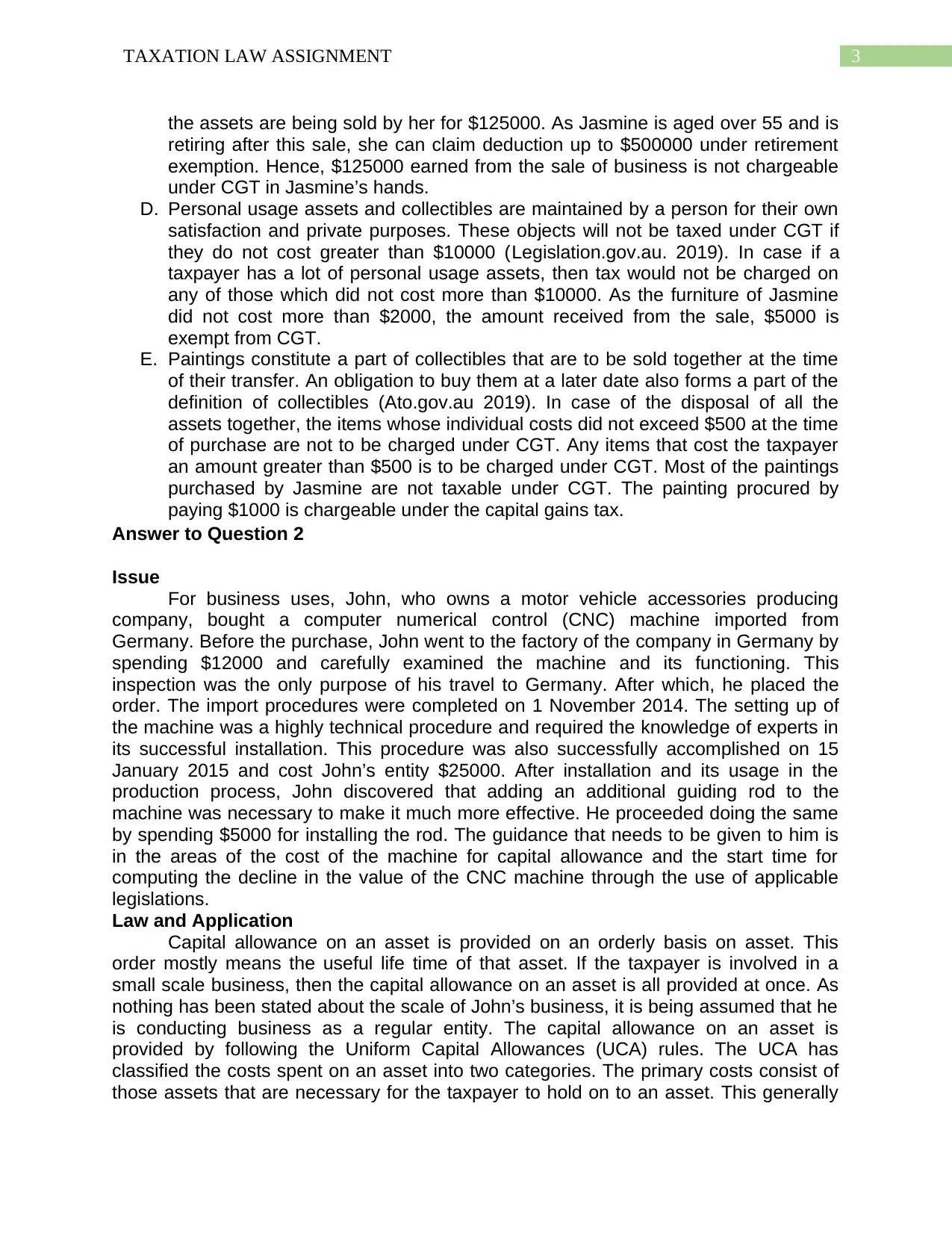
3TAXATION LAW ASSIGNMENT
the assets are being sold by her for $125000. As Jasmine is aged over 55 and is
retiring after this sale, she can claim deduction up to $500000 under retirement
exemption. Hence, $125000 earned from the sale of business is not chargeable
under CGT in Jasmine’s hands.
D. Personal usage assets and collectibles are maintained by a person for their own
satisfaction and private purposes. These objects will not be taxed under CGT if
they do not cost greater than $10000 (Legislation.gov.au. 2019). In case if a
taxpayer has a lot of personal usage assets, then tax would not be charged on
any of those which did not cost more than $10000. As the furniture of Jasmine
did not cost more than $2000, the amount received from the sale, $5000 is
exempt from CGT.
E. Paintings constitute a part of collectibles that are to be sold together at the time
of their transfer. An obligation to buy them at a later date also forms a part of the
definition of collectibles (Ato.gov.au 2019). In case of the disposal of all the
assets together, the items whose individual costs did not exceed $500 at the time
of purchase are not to be charged under CGT. Any items that cost the taxpayer
an amount greater than $500 is to be charged under CGT. Most of the paintings
purchased by Jasmine are not taxable under CGT. The painting procured by
paying $1000 is chargeable under the capital gains tax.
Answer to Question 2
Issue
For business uses, John, who owns a motor vehicle accessories producing
company, bought a computer numerical control (CNC) machine imported from
Germany. Before the purchase, John went to the factory of the company in Germany by
spending $12000 and carefully examined the machine and its functioning. This
inspection was the only purpose of his travel to Germany. After which, he placed the
order. The import procedures were completed on 1 November 2014. The setting up of
the machine was a highly technical procedure and required the knowledge of experts in
its successful installation. This procedure was also successfully accomplished on 15
January 2015 and cost John’s entity $25000. After installation and its usage in the
production process, John discovered that adding an additional guiding rod to the
machine was necessary to make it much more effective. He proceeded doing the same
by spending $5000 for installing the rod. The guidance that needs to be given to him is
in the areas of the cost of the machine for capital allowance and the start time for
computing the decline in the value of the CNC machine through the use of applicable
legislations.
Law and Application
Capital allowance on an asset is provided on an orderly basis on asset. This
order mostly means the useful life time of that asset. If the taxpayer is involved in a
small scale business, then the capital allowance on an asset is all provided at once. As
nothing has been stated about the scale of John’s business, it is being assumed that he
is conducting business as a regular entity. The capital allowance on an asset is
provided by following the Uniform Capital Allowances (UCA) rules. The UCA has
classified the costs spent on an asset into two categories. The primary costs consist of
those assets that are necessary for the taxpayer to hold on to an asset. This generally
the assets are being sold by her for $125000. As Jasmine is aged over 55 and is
retiring after this sale, she can claim deduction up to $500000 under retirement
exemption. Hence, $125000 earned from the sale of business is not chargeable
under CGT in Jasmine’s hands.
D. Personal usage assets and collectibles are maintained by a person for their own
satisfaction and private purposes. These objects will not be taxed under CGT if
they do not cost greater than $10000 (Legislation.gov.au. 2019). In case if a
taxpayer has a lot of personal usage assets, then tax would not be charged on
any of those which did not cost more than $10000. As the furniture of Jasmine
did not cost more than $2000, the amount received from the sale, $5000 is
exempt from CGT.
E. Paintings constitute a part of collectibles that are to be sold together at the time
of their transfer. An obligation to buy them at a later date also forms a part of the
definition of collectibles (Ato.gov.au 2019). In case of the disposal of all the
assets together, the items whose individual costs did not exceed $500 at the time
of purchase are not to be charged under CGT. Any items that cost the taxpayer
an amount greater than $500 is to be charged under CGT. Most of the paintings
purchased by Jasmine are not taxable under CGT. The painting procured by
paying $1000 is chargeable under the capital gains tax.
Answer to Question 2
Issue
For business uses, John, who owns a motor vehicle accessories producing
company, bought a computer numerical control (CNC) machine imported from
Germany. Before the purchase, John went to the factory of the company in Germany by
spending $12000 and carefully examined the machine and its functioning. This
inspection was the only purpose of his travel to Germany. After which, he placed the
order. The import procedures were completed on 1 November 2014. The setting up of
the machine was a highly technical procedure and required the knowledge of experts in
its successful installation. This procedure was also successfully accomplished on 15
January 2015 and cost John’s entity $25000. After installation and its usage in the
production process, John discovered that adding an additional guiding rod to the
machine was necessary to make it much more effective. He proceeded doing the same
by spending $5000 for installing the rod. The guidance that needs to be given to him is
in the areas of the cost of the machine for capital allowance and the start time for
computing the decline in the value of the CNC machine through the use of applicable
legislations.
Law and Application
Capital allowance on an asset is provided on an orderly basis on asset. This
order mostly means the useful life time of that asset. If the taxpayer is involved in a
small scale business, then the capital allowance on an asset is all provided at once. As
nothing has been stated about the scale of John’s business, it is being assumed that he
is conducting business as a regular entity. The capital allowance on an asset is
provided by following the Uniform Capital Allowances (UCA) rules. The UCA has
classified the costs spent on an asset into two categories. The primary costs consist of
those assets that are necessary for the taxpayer to hold on to an asset. This generally
Paraphrase This Document
Need a fresh take? Get an instant paraphrase of this document with our AI Paraphraser
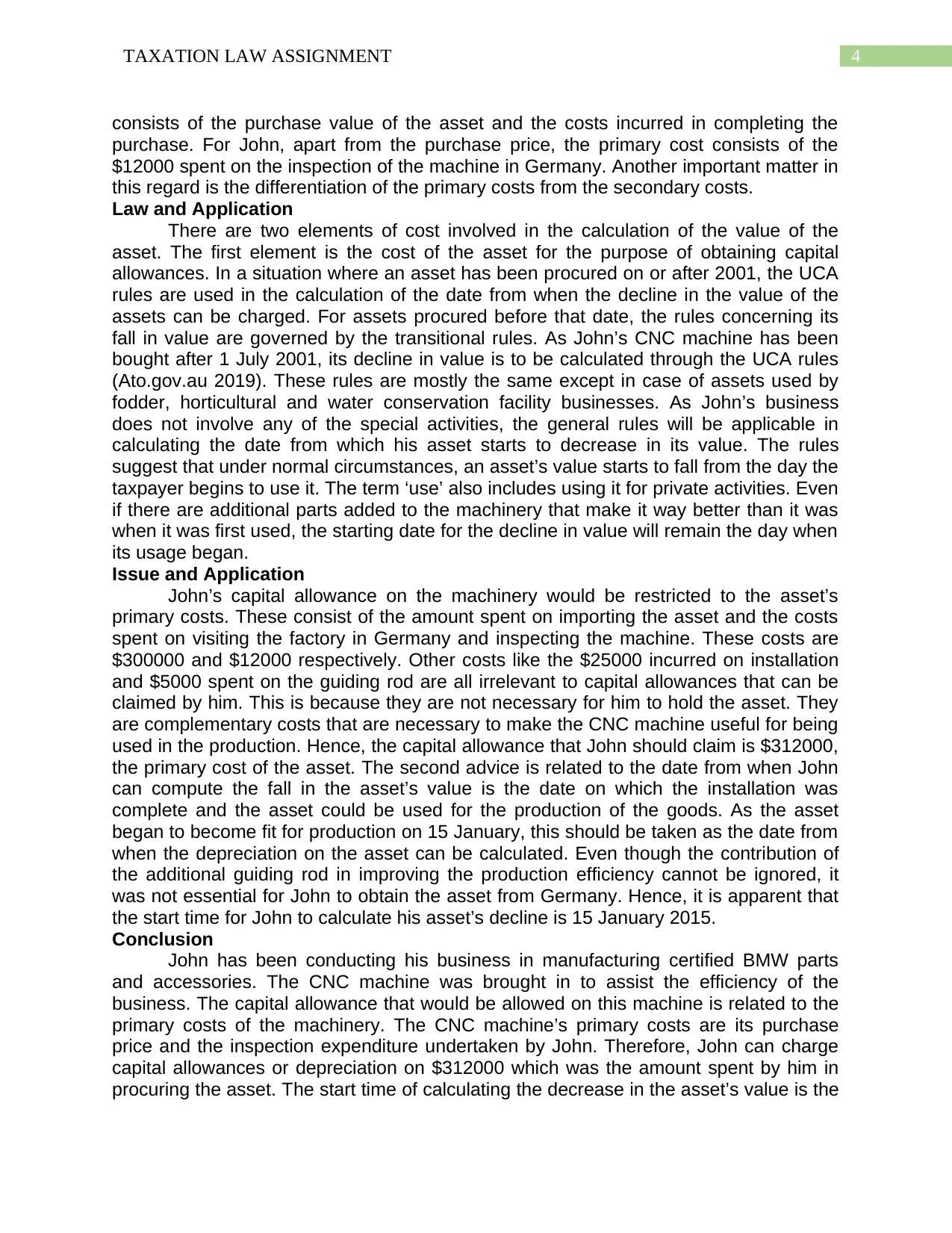
4TAXATION LAW ASSIGNMENT
consists of the purchase value of the asset and the costs incurred in completing the
purchase. For John, apart from the purchase price, the primary cost consists of the
$12000 spent on the inspection of the machine in Germany. Another important matter in
this regard is the differentiation of the primary costs from the secondary costs.
Law and Application
There are two elements of cost involved in the calculation of the value of the
asset. The first element is the cost of the asset for the purpose of obtaining capital
allowances. In a situation where an asset has been procured on or after 2001, the UCA
rules are used in the calculation of the date from when the decline in the value of the
assets can be charged. For assets procured before that date, the rules concerning its
fall in value are governed by the transitional rules. As John’s CNC machine has been
bought after 1 July 2001, its decline in value is to be calculated through the UCA rules
(Ato.gov.au 2019). These rules are mostly the same except in case of assets used by
fodder, horticultural and water conservation facility businesses. As John’s business
does not involve any of the special activities, the general rules will be applicable in
calculating the date from which his asset starts to decrease in its value. The rules
suggest that under normal circumstances, an asset’s value starts to fall from the day the
taxpayer begins to use it. The term ‘use’ also includes using it for private activities. Even
if there are additional parts added to the machinery that make it way better than it was
when it was first used, the starting date for the decline in value will remain the day when
its usage began.
Issue and Application
John’s capital allowance on the machinery would be restricted to the asset’s
primary costs. These consist of the amount spent on importing the asset and the costs
spent on visiting the factory in Germany and inspecting the machine. These costs are
$300000 and $12000 respectively. Other costs like the $25000 incurred on installation
and $5000 spent on the guiding rod are all irrelevant to capital allowances that can be
claimed by him. This is because they are not necessary for him to hold the asset. They
are complementary costs that are necessary to make the CNC machine useful for being
used in the production. Hence, the capital allowance that John should claim is $312000,
the primary cost of the asset. The second advice is related to the date from when John
can compute the fall in the asset’s value is the date on which the installation was
complete and the asset could be used for the production of the goods. As the asset
began to become fit for production on 15 January, this should be taken as the date from
when the depreciation on the asset can be calculated. Even though the contribution of
the additional guiding rod in improving the production efficiency cannot be ignored, it
was not essential for John to obtain the asset from Germany. Hence, it is apparent that
the start time for John to calculate his asset’s decline is 15 January 2015.
Conclusion
John has been conducting his business in manufacturing certified BMW parts
and accessories. The CNC machine was brought in to assist the efficiency of the
business. The capital allowance that would be allowed on this machine is related to the
primary costs of the machinery. The CNC machine’s primary costs are its purchase
price and the inspection expenditure undertaken by John. Therefore, John can charge
capital allowances or depreciation on $312000 which was the amount spent by him in
procuring the asset. The start time of calculating the decrease in the asset’s value is the
consists of the purchase value of the asset and the costs incurred in completing the
purchase. For John, apart from the purchase price, the primary cost consists of the
$12000 spent on the inspection of the machine in Germany. Another important matter in
this regard is the differentiation of the primary costs from the secondary costs.
Law and Application
There are two elements of cost involved in the calculation of the value of the
asset. The first element is the cost of the asset for the purpose of obtaining capital
allowances. In a situation where an asset has been procured on or after 2001, the UCA
rules are used in the calculation of the date from when the decline in the value of the
assets can be charged. For assets procured before that date, the rules concerning its
fall in value are governed by the transitional rules. As John’s CNC machine has been
bought after 1 July 2001, its decline in value is to be calculated through the UCA rules
(Ato.gov.au 2019). These rules are mostly the same except in case of assets used by
fodder, horticultural and water conservation facility businesses. As John’s business
does not involve any of the special activities, the general rules will be applicable in
calculating the date from which his asset starts to decrease in its value. The rules
suggest that under normal circumstances, an asset’s value starts to fall from the day the
taxpayer begins to use it. The term ‘use’ also includes using it for private activities. Even
if there are additional parts added to the machinery that make it way better than it was
when it was first used, the starting date for the decline in value will remain the day when
its usage began.
Issue and Application
John’s capital allowance on the machinery would be restricted to the asset’s
primary costs. These consist of the amount spent on importing the asset and the costs
spent on visiting the factory in Germany and inspecting the machine. These costs are
$300000 and $12000 respectively. Other costs like the $25000 incurred on installation
and $5000 spent on the guiding rod are all irrelevant to capital allowances that can be
claimed by him. This is because they are not necessary for him to hold the asset. They
are complementary costs that are necessary to make the CNC machine useful for being
used in the production. Hence, the capital allowance that John should claim is $312000,
the primary cost of the asset. The second advice is related to the date from when John
can compute the fall in the asset’s value is the date on which the installation was
complete and the asset could be used for the production of the goods. As the asset
began to become fit for production on 15 January, this should be taken as the date from
when the depreciation on the asset can be calculated. Even though the contribution of
the additional guiding rod in improving the production efficiency cannot be ignored, it
was not essential for John to obtain the asset from Germany. Hence, it is apparent that
the start time for John to calculate his asset’s decline is 15 January 2015.
Conclusion
John has been conducting his business in manufacturing certified BMW parts
and accessories. The CNC machine was brought in to assist the efficiency of the
business. The capital allowance that would be allowed on this machine is related to the
primary costs of the machinery. The CNC machine’s primary costs are its purchase
price and the inspection expenditure undertaken by John. Therefore, John can charge
capital allowances or depreciation on $312000 which was the amount spent by him in
procuring the asset. The start time of calculating the decrease in the asset’s value is the
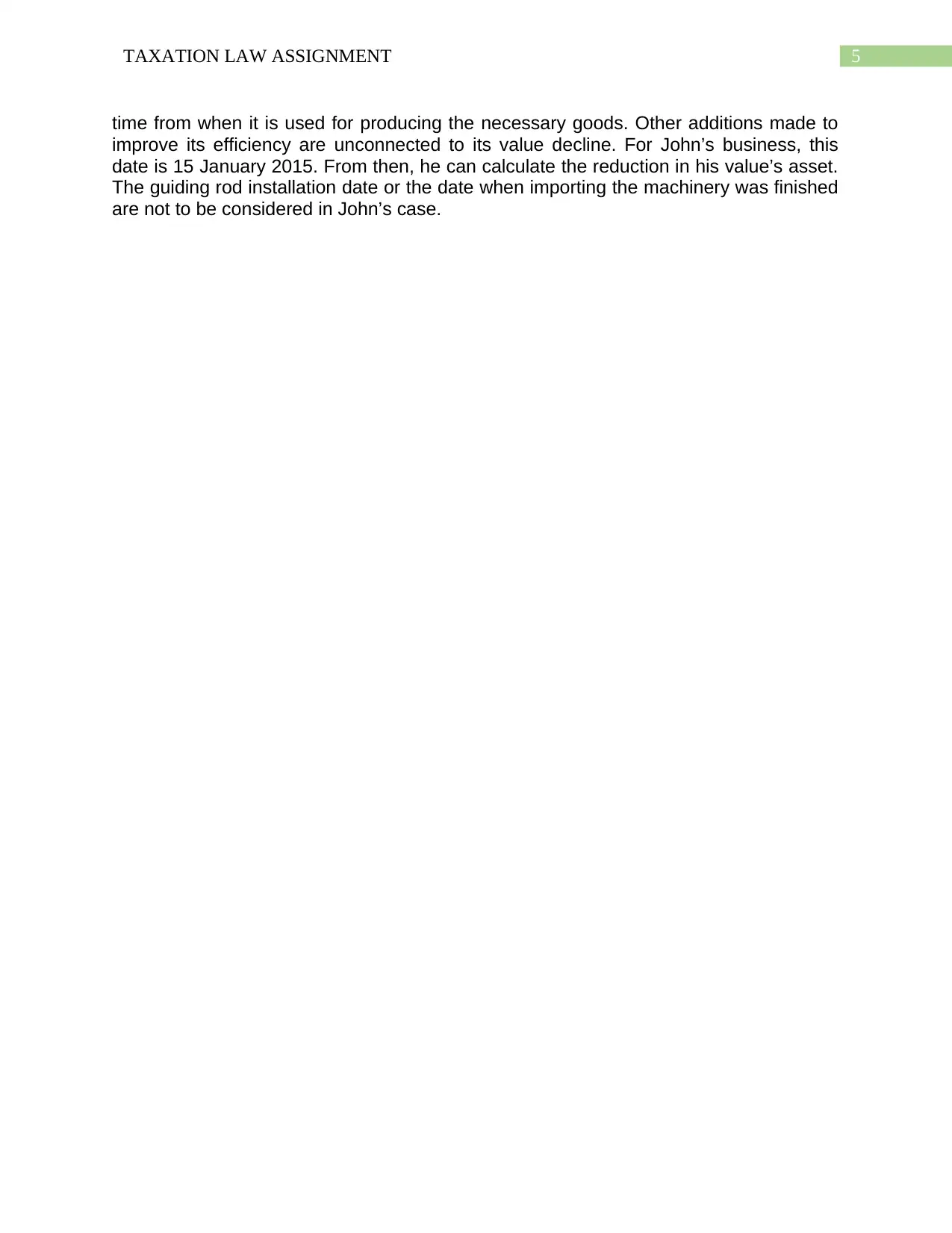
5TAXATION LAW ASSIGNMENT
time from when it is used for producing the necessary goods. Other additions made to
improve its efficiency are unconnected to its value decline. For John’s business, this
date is 15 January 2015. From then, he can calculate the reduction in his value’s asset.
The guiding rod installation date or the date when importing the machinery was finished
are not to be considered in John’s case.
time from when it is used for producing the necessary goods. Other additions made to
improve its efficiency are unconnected to its value decline. For John’s business, this
date is 15 January 2015. From then, he can calculate the reduction in his value’s asset.
The guiding rod installation date or the date when importing the machinery was finished
are not to be considered in John’s case.
⊘ This is a preview!⊘
Do you want full access?
Subscribe today to unlock all pages.

Trusted by 1+ million students worldwide
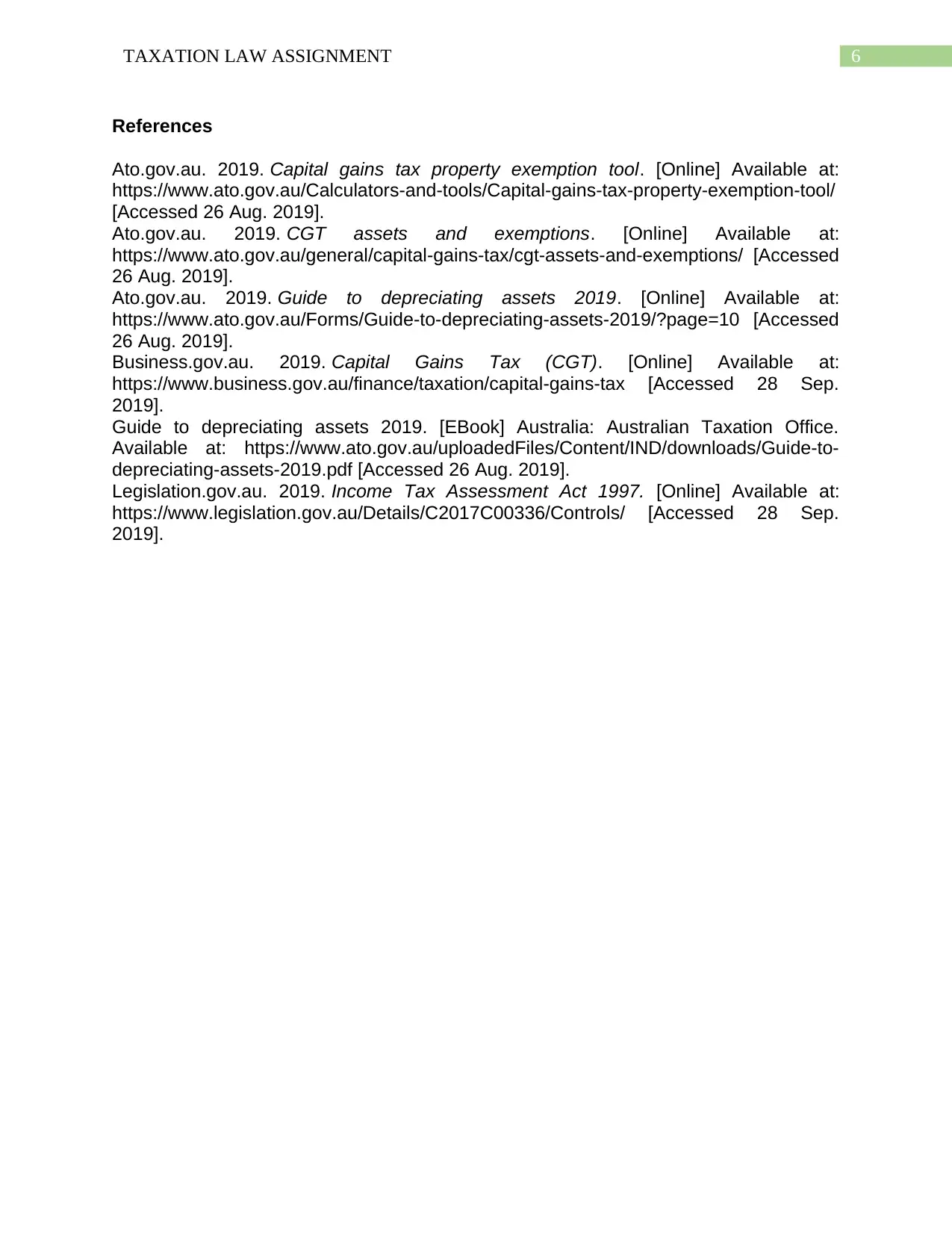
6TAXATION LAW ASSIGNMENT
References
Ato.gov.au. 2019. Capital gains tax property exemption tool. [Online] Available at:
https://www.ato.gov.au/Calculators-and-tools/Capital-gains-tax-property-exemption-tool/
[Accessed 26 Aug. 2019].
Ato.gov.au. 2019. CGT assets and exemptions. [Online] Available at:
https://www.ato.gov.au/general/capital-gains-tax/cgt-assets-and-exemptions/ [Accessed
26 Aug. 2019].
Ato.gov.au. 2019. Guide to depreciating assets 2019. [Online] Available at:
https://www.ato.gov.au/Forms/Guide-to-depreciating-assets-2019/?page=10 [Accessed
26 Aug. 2019].
Business.gov.au. 2019. Capital Gains Tax (CGT). [Online] Available at:
https://www.business.gov.au/finance/taxation/capital-gains-tax [Accessed 28 Sep.
2019].
Guide to depreciating assets 2019. [EBook] Australia: Australian Taxation Office.
Available at: https://www.ato.gov.au/uploadedFiles/Content/IND/downloads/Guide-to-
depreciating-assets-2019.pdf [Accessed 26 Aug. 2019].
Legislation.gov.au. 2019. Income Tax Assessment Act 1997. [Online] Available at:
https://www.legislation.gov.au/Details/C2017C00336/Controls/ [Accessed 28 Sep.
2019].
References
Ato.gov.au. 2019. Capital gains tax property exemption tool. [Online] Available at:
https://www.ato.gov.au/Calculators-and-tools/Capital-gains-tax-property-exemption-tool/
[Accessed 26 Aug. 2019].
Ato.gov.au. 2019. CGT assets and exemptions. [Online] Available at:
https://www.ato.gov.au/general/capital-gains-tax/cgt-assets-and-exemptions/ [Accessed
26 Aug. 2019].
Ato.gov.au. 2019. Guide to depreciating assets 2019. [Online] Available at:
https://www.ato.gov.au/Forms/Guide-to-depreciating-assets-2019/?page=10 [Accessed
26 Aug. 2019].
Business.gov.au. 2019. Capital Gains Tax (CGT). [Online] Available at:
https://www.business.gov.au/finance/taxation/capital-gains-tax [Accessed 28 Sep.
2019].
Guide to depreciating assets 2019. [EBook] Australia: Australian Taxation Office.
Available at: https://www.ato.gov.au/uploadedFiles/Content/IND/downloads/Guide-to-
depreciating-assets-2019.pdf [Accessed 26 Aug. 2019].
Legislation.gov.au. 2019. Income Tax Assessment Act 1997. [Online] Available at:
https://www.legislation.gov.au/Details/C2017C00336/Controls/ [Accessed 28 Sep.
2019].
1 out of 7
Related Documents
Your All-in-One AI-Powered Toolkit for Academic Success.
+13062052269
info@desklib.com
Available 24*7 on WhatsApp / Email
![[object Object]](/_next/static/media/star-bottom.7253800d.svg)
Unlock your academic potential
Copyright © 2020–2025 A2Z Services. All Rights Reserved. Developed and managed by ZUCOL.





